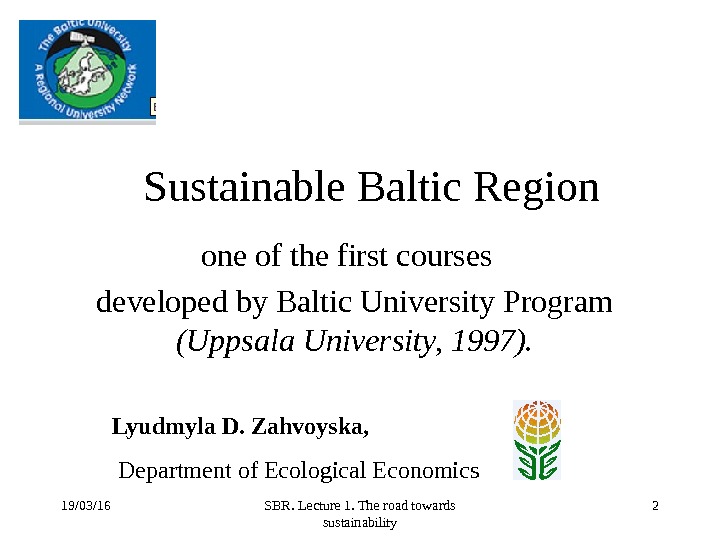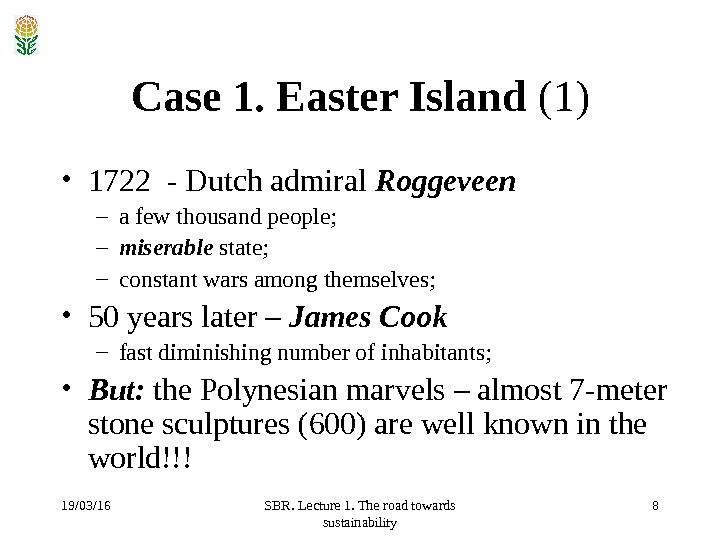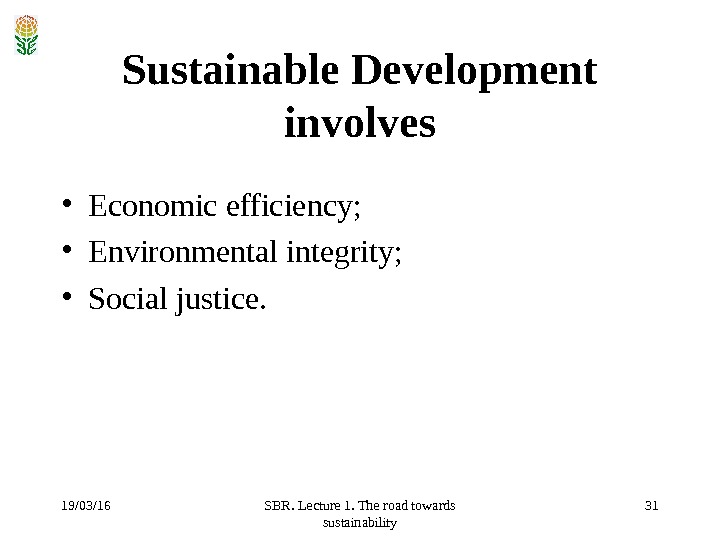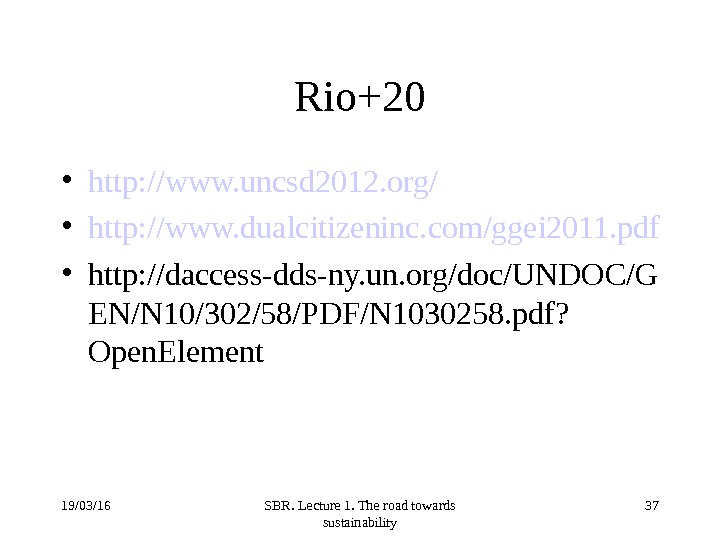19/03/16 SBR. Lecture 1. The road towards sustainability






































lecture_1._road_twd_sust-ty11.ppt
- Размер: 4.1 Mегабайта
- Количество слайдов: 37
Описание презентации 19/03/16 SBR. Lecture 1. The road towards sustainability по слайдам
 19/03/16 SBR. Lecture 1. The road towards sustainability 1 Baltic University Program Regional university network Central aim of the Baltic University Program is to distribute knowledge to entire region so as to achieve a common understanding of the nature and dimensions of the challenge we are facing.
19/03/16 SBR. Lecture 1. The road towards sustainability 1 Baltic University Program Regional university network Central aim of the Baltic University Program is to distribute knowledge to entire region so as to achieve a common understanding of the nature and dimensions of the challenge we are facing.
 19/03/16 SBR. Lecture 1. The road towards sustainability 2 Sustainable Baltic Region one of the first courses developed by Baltic University Program (Uppsala University, 1997). Lyudmyla D. Zahvoyska, Department of Ecological Economics
19/03/16 SBR. Lecture 1. The road towards sustainability 2 Sustainable Baltic Region one of the first courses developed by Baltic University Program (Uppsala University, 1997). Lyudmyla D. Zahvoyska, Department of Ecological Economics
 19/03/16 SBR. Lecture 1. The road towards sustainability 3 Друкувати з примітками! Безмовна весна. Керсон
19/03/16 SBR. Lecture 1. The road towards sustainability 3 Друкувати з примітками! Безмовна весна. Керсон
 19/03/16 SBR. Lecture 1. The road towards sustainability 4 Lecture 1. The Road towards Sustainability. A historical perspective Sustainable Baltic Region course. Baltic University Program
19/03/16 SBR. Lecture 1. The road towards sustainability 4 Lecture 1. The Road towards Sustainability. A historical perspective Sustainable Baltic Region course. Baltic University Program
 19/03/16 SBR. Lecture 1. The road towards sustainability 5 The Road towards Sustainability 1. Islands – global lessons from micro-worlds 2. The environmental dilemma – a history of scientists and social constructions 3. Baltic region eco-strategies 4. Paradigms of sustainability
19/03/16 SBR. Lecture 1. The road towards sustainability 5 The Road towards Sustainability 1. Islands – global lessons from micro-worlds 2. The environmental dilemma – a history of scientists and social constructions 3. Baltic region eco-strategies 4. Paradigms of sustainability
 19/03/16 SBR. Lecture 1. The road towards sustainability 6 Literature 1. The Road towards Sustainability. A historical perspective. S. Sorling (Ed. ) – Uppsala: BUP, 1997. – 48 p. 2. Программа действий. Повестка дня на 21 век и другие документы конференции в Рио-де-Жанейро в популярном изложении / Сост. : М. Китинг. – Женева: Центр «За наше общее будущее» , 1993. – 70 с. 3. Дейлі Г. Поза зростанням. Економічна теорія сталого розвитку. – К. : Інтелсфера, 2002. – 312 с. 4. Ґор А. Земля у рівновазі. Екологія і людський дух. – К. : Інтелсфера, 2001.
19/03/16 SBR. Lecture 1. The road towards sustainability 6 Literature 1. The Road towards Sustainability. A historical perspective. S. Sorling (Ed. ) – Uppsala: BUP, 1997. – 48 p. 2. Программа действий. Повестка дня на 21 век и другие документы конференции в Рио-де-Жанейро в популярном изложении / Сост. : М. Китинг. – Женева: Центр «За наше общее будущее» , 1993. – 70 с. 3. Дейлі Г. Поза зростанням. Економічна теорія сталого розвитку. – К. : Інтелсфера, 2002. – 312 с. 4. Ґор А. Земля у рівновазі. Екологія і людський дух. – К. : Інтелсфера, 2001.
 19/03/16 SBR. Lecture 1. The road towards sustainability 71. Islands – global lessons from micro-worlds
19/03/16 SBR. Lecture 1. The road towards sustainability 71. Islands – global lessons from micro-worlds
 19/03/16 SBR. Lecture 1. The road towards sustainability 8 Case 1. Easter Island (1) • 1722 — Dutch admiral Roggeveen – a few thousand people; – miserable state; – constant wars among themselves; • 50 years later – James Cook – fast diminishing number of inhabitants; • But: the Polynesian marvels – almost 7 -meter stone sculptures (600) are well known in the world!!!
19/03/16 SBR. Lecture 1. The road towards sustainability 8 Case 1. Easter Island (1) • 1722 — Dutch admiral Roggeveen – a few thousand people; – miserable state; – constant wars among themselves; • 50 years later – James Cook – fast diminishing number of inhabitants; • But: the Polynesian marvels – almost 7 -meter stone sculptures (600) are well known in the world!!!
 19/03/16 SBR. Lecture 1. The road towards sustainability 9 How it could happened? ! How these wretched creatures have produced such marvels? ! Clive Pointing. A Green History of the World. – London: Penguin,
19/03/16 SBR. Lecture 1. The road towards sustainability 9 How it could happened? ! How these wretched creatures have produced such marvels? ! Clive Pointing. A Green History of the World. – London: Penguin,
 19/03/16 SBR. Lecture 1. The road towards sustainability 10 Case 1. Easter Island (3) Pointing, 1991 • First Polynesians – 20 -30 persons; • Uncomplicated island ecosystem (30 types of plants, a couple of kinds of lizards, plus some fish); • The humans brought a species of hen, sweet potato; • Community grew to 7 thousand people.
19/03/16 SBR. Lecture 1. The road towards sustainability 10 Case 1. Easter Island (3) Pointing, 1991 • First Polynesians – 20 -30 persons; • Uncomplicated island ecosystem (30 types of plants, a couple of kinds of lizards, plus some fish); • The humans brought a species of hen, sweet potato; • Community grew to 7 thousand people.
 19/03/16 SBR. Lecture 1. The road towards sustainability 11 Case 1. Easter Island ( 4 ) Pointing, 1991 • Community grew to 7 thousand people; • First clans were formed; • People spent their energy on arts, ceremonies and mnemothechniqs; • Cult of birds; • Worshipping ancestors ( поклоніння предкам ) ; • Cult sites, sculpture; • Wooden roads; • Ceremonies competition; • Intensive forest cutting.
19/03/16 SBR. Lecture 1. The road towards sustainability 11 Case 1. Easter Island ( 4 ) Pointing, 1991 • Community grew to 7 thousand people; • First clans were formed; • People spent their energy on arts, ceremonies and mnemothechniqs; • Cult of birds; • Worshipping ancestors ( поклоніння предкам ) ; • Cult sites, sculpture; • Wooden roads; • Ceremonies competition; • Intensive forest cutting.
 19/03/16 SBR. Lecture 1. The road towards sustainability 12 Case 1. Easter Island ( 5 ) Pointing, 1991 • Intensive forest cutting resulted in: – no fishing (no boats), – soil erosion, – no harvest and food; • in a 100 years population decreased by 50 %; • The speed of these changes prove several hundreds sculptures which are still lying around near quarry in different stages of completion.
19/03/16 SBR. Lecture 1. The road towards sustainability 12 Case 1. Easter Island ( 5 ) Pointing, 1991 • Intensive forest cutting resulted in: – no fishing (no boats), – soil erosion, – no harvest and food; • in a 100 years population decreased by 50 %; • The speed of these changes prove several hundreds sculptures which are still lying around near quarry in different stages of completion.
 19/03/16 SBR. Lecture 1. The road towards sustainability 13 Case 1. Easter Island ( 5 ) • Intensive forest cutting resulted in: – no fishing (no boats), – soil erosion, – no harvest and food; • in a 100 years population decreased by 50 %; • The speed of these changes prove several hundreds sculptures which are still lying around near quarry in different stages of completion. T h e d e c isiv e fa c to r w a s S e lf-d e str u c tiv e b e h a v io r
19/03/16 SBR. Lecture 1. The road towards sustainability 13 Case 1. Easter Island ( 5 ) • Intensive forest cutting resulted in: – no fishing (no boats), – soil erosion, – no harvest and food; • in a 100 years population decreased by 50 %; • The speed of these changes prove several hundreds sculptures which are still lying around near quarry in different stages of completion. T h e d e c isiv e fa c to r w a s S e lf-d e str u c tiv e b e h a v io r
 19/03/16 SBR. Lecture 1. The road towards sustainability 14 Case 2. Hawaii ( 1 ) Alfred Crosby. Ecological imperialism, 1986 • 1778 – James Cook arrived in Hawaii: – Strongly isolated island: • 96% of plants live only there; • The only generic (widespread) mammal is a species of bat; – Flourishing Polynesians community • But they also went through a disaster; • The decisive factor was diseases , caused by changing lifestyle: – leaving traditional areas; – cutting sandal trees, which were used as currency in trade.
19/03/16 SBR. Lecture 1. The road towards sustainability 14 Case 2. Hawaii ( 1 ) Alfred Crosby. Ecological imperialism, 1986 • 1778 – James Cook arrived in Hawaii: – Strongly isolated island: • 96% of plants live only there; • The only generic (widespread) mammal is a species of bat; – Flourishing Polynesians community • But they also went through a disaster; • The decisive factor was diseases , caused by changing lifestyle: – leaving traditional areas; – cutting sandal trees, which were used as currency in trade.
 19/03/16 SBR. Lecture 1. The road towards sustainability 15 Case 2. Hawaii ( 2 ) A. Crosby, 1994 • Epidemic disease ( lack of immunological protection); • Population decline in order of 75 -95 %; • Europeans brought disease to a virgin soils.
19/03/16 SBR. Lecture 1. The road towards sustainability 15 Case 2. Hawaii ( 2 ) A. Crosby, 1994 • Epidemic disease ( lack of immunological protection); • Population decline in order of 75 -95 %; • Europeans brought disease to a virgin soils.
 19/03/16 SBR. Lecture 1. The road towards sustainability 16 Case 3. Cape Verde, New Zealand Lindskog & Delaite, 1996 • Absence of local population; • Vast and luscious forests; • Abundance of streams; Portuguese brought domesticated animals (goats !) Green islands became barren, stripped and droughts. ( безплідні, голі і засушливі )
19/03/16 SBR. Lecture 1. The road towards sustainability 16 Case 3. Cape Verde, New Zealand Lindskog & Delaite, 1996 • Absence of local population; • Vast and luscious forests; • Abundance of streams; Portuguese brought domesticated animals (goats !) Green islands became barren, stripped and droughts. ( безплідні, голі і засушливі )
 19/03/16 SBR. Lecture 1. The road towards sustainability 17 Lessons from Micro-World • Several stories about relationships between man and his changed environment; • Dismal environmental encounters between Europeans and biota of ocean islands; • XVIII-XIX centuries — an early conservation movement; • Investigating connection between environmental decay (especially deforestation) and climate change; • Global role of tropical ecosystems; • Place of human greed and selfishness ( жадібність та егоїзм ).
19/03/16 SBR. Lecture 1. The road towards sustainability 17 Lessons from Micro-World • Several stories about relationships between man and his changed environment; • Dismal environmental encounters between Europeans and biota of ocean islands; • XVIII-XIX centuries — an early conservation movement; • Investigating connection between environmental decay (especially deforestation) and climate change; • Global role of tropical ecosystems; • Place of human greed and selfishness ( жадібність та егоїзм ).
 19/03/16 SBR. Lecture 1. The road towards sustainability 18 Exclusion s in Dismal Island Experience • Successful colonization of Iceland by Norsemen; • Aboriginals of North America managed to resist European colonizations; • Local population of Greenland was ultimately better suited to climate circumstances then Norsemen.
19/03/16 SBR. Lecture 1. The road towards sustainability 18 Exclusion s in Dismal Island Experience • Successful colonization of Iceland by Norsemen; • Aboriginals of North America managed to resist European colonizations; • Local population of Greenland was ultimately better suited to climate circumstances then Norsemen.
 19/03/16 SBR. Lecture 1. The road towards sustainability 19 TED program • http: //www. youtube. com/watch? v=IESYMFt. LIis
19/03/16 SBR. Lecture 1. The road towards sustainability 19 TED program • http: //www. youtube. com/watch? v=IESYMFt. LIis
 19/03/16 SBR. Lecture 1. The road towards sustainability 202. The environmental dilemma – a history of scientists and social constructions
19/03/16 SBR. Lecture 1. The road towards sustainability 202. The environmental dilemma – a history of scientists and social constructions
 19/03/16 SBR. Lecture 1. The road towards sustainability 21 Early societies and environmental impact • Environmental problems have always been a part of human condition: – Hunting; – Agriculture with irrigation; – Gathering; – Landscape intrusion; – Handicraft (ремесло).
19/03/16 SBR. Lecture 1. The road towards sustainability 21 Early societies and environmental impact • Environmental problems have always been a part of human condition: – Hunting; – Agriculture with irrigation; – Gathering; – Landscape intrusion; – Handicraft (ремесло).
 19/03/16 SBR. Lecture 1. The road towards sustainability 22 What is an environmental problem? A tricky concept • In all places in all times we face with human impacts; • In yesterday conditions today’s problems don’t look as a problem.
19/03/16 SBR. Lecture 1. The road towards sustainability 22 What is an environmental problem? A tricky concept • In all places in all times we face with human impacts; • In yesterday conditions today’s problems don’t look as a problem.
 19/03/16 SBR. Lecture 1. The road towards sustainability 23 Establishment of Environmental Problems • Several levels; • The physical level — where detrimental phenomena occur and can be recorded or measured; • The description of environmental change as a “problem” is an interpretation by contemporary scientists (environmentalists, historians, archeologists).
19/03/16 SBR. Lecture 1. The road towards sustainability 23 Establishment of Environmental Problems • Several levels; • The physical level — where detrimental phenomena occur and can be recorded or measured; • The description of environmental change as a “problem” is an interpretation by contemporary scientists (environmentalists, historians, archeologists).
 19/03/16 SBR. Lecture 1. The road towards sustainability 24 The role of science and scientists On intellectual level problem is discovered and depicted , but not demanded by society, for instance: • Bad quality of air in London ( Evelyn, 1661 ); • Mechanism of soil erosion in Alps ( Fabre , ); • Nature of river floods ( G. Marsh, 1864 ); • Principles of eutrophication ( E. Naumann , early XX c); • Large-scale acidification (S. Oden, 1967).
19/03/16 SBR. Lecture 1. The road towards sustainability 24 The role of science and scientists On intellectual level problem is discovered and depicted , but not demanded by society, for instance: • Bad quality of air in London ( Evelyn, 1661 ); • Mechanism of soil erosion in Alps ( Fabre , ); • Nature of river floods ( G. Marsh, 1864 ); • Principles of eutrophication ( E. Naumann , early XX c); • Large-scale acidification (S. Oden, 1967).
 19/03/16 SBR. Lecture 1. The road towards sustainability 25 It is not enough to create knowledge! “ Political infrastructure ” was needed • Construction of environmental agenda is a social process; • It takes social interests, social movements, concerned citizens and alarming scientists; • S. Oden was heard because in the 1960 s an environmental agenda had been formed due to Rachel Carson (‘ Silent Spring’ ), Georg Borgstrom et. al.
19/03/16 SBR. Lecture 1. The road towards sustainability 25 It is not enough to create knowledge! “ Political infrastructure ” was needed • Construction of environmental agenda is a social process; • It takes social interests, social movements, concerned citizens and alarming scientists; • S. Oden was heard because in the 1960 s an environmental agenda had been formed due to Rachel Carson (‘ Silent Spring’ ), Georg Borgstrom et. al.
 19/03/16 SBR. Lecture 1. The road towards sustainability 26 Importance of environmental agenda: Examples of environmental science stories • H. Ahlmann discovered melting glaciers in Arctic (Sweden, first half of XX century); • S. Arrhenius described mechanism of global warming, linked rising annual temperature to human activities. Greenhouse theory (Sweden , 1896); • G. Callendar set links between the burning of fossil fuels and rising annual temperature (Great Britain, 1938); • But they did not see this phenomena as an environmental problem. Why? • Because society did not recognize it. It was not ‘hot’ question.
19/03/16 SBR. Lecture 1. The road towards sustainability 26 Importance of environmental agenda: Examples of environmental science stories • H. Ahlmann discovered melting glaciers in Arctic (Sweden, first half of XX century); • S. Arrhenius described mechanism of global warming, linked rising annual temperature to human activities. Greenhouse theory (Sweden , 1896); • G. Callendar set links between the burning of fossil fuels and rising annual temperature (Great Britain, 1938); • But they did not see this phenomena as an environmental problem. Why? • Because society did not recognize it. It was not ‘hot’ question.
 19/03/16 SBR. Lecture 1. The road towards sustainability 27 The environmental paradigm • Arose when local, scattered and isolated in time and place problems obtained such single unifying characteristic as: ‘ they were problems of man’s relation with his environment’. • How long did it take? In case of London it took 700 years!!! • The environmental paradigm was a powerful interpretative tool that was now put into hands and minds of journalists, politicians, scientists, citizens.
19/03/16 SBR. Lecture 1. The road towards sustainability 27 The environmental paradigm • Arose when local, scattered and isolated in time and place problems obtained such single unifying characteristic as: ‘ they were problems of man’s relation with his environment’. • How long did it take? In case of London it took 700 years!!! • The environmental paradigm was a powerful interpretative tool that was now put into hands and minds of journalists, politicians, scientists, citizens.
 19/03/16 SBR. Lecture 1. The road towards sustainability 28 The environmental agenda as a social process • The environmental problematique is maturing as a social phenomena; • It entangled in more sectors of society; • Environmental issues become a part of everyday life of virtually every citizen; • Institutions are built; • Legislation is being reinforced; • Policy is widening; • Scientist could serve a discoverer, a teacher, an advisor, a responsible intellectual.
19/03/16 SBR. Lecture 1. The road towards sustainability 28 The environmental agenda as a social process • The environmental problematique is maturing as a social phenomena; • It entangled in more sectors of society; • Environmental issues become a part of everyday life of virtually every citizen; • Institutions are built; • Legislation is being reinforced; • Policy is widening; • Scientist could serve a discoverer, a teacher, an advisor, a responsible intellectual.
 19/03/16 SBR. Lecture 1. The road towards sustainability 294. Paradigms of sustainability
19/03/16 SBR. Lecture 1. The road towards sustainability 294. Paradigms of sustainability
 19/03/16 SBR. Lecture 1. The road towards sustainability 30 Essence of Sustainable Development “ Sustainable Development meets the needs of present generation without compromising the ability of future generations to meet their needs”. (Brundtland Report)
19/03/16 SBR. Lecture 1. The road towards sustainability 30 Essence of Sustainable Development “ Sustainable Development meets the needs of present generation without compromising the ability of future generations to meet their needs”. (Brundtland Report)
 19/03/16 SBR. Lecture 1. The road towards sustainability 31 Sustainable Development involves • Economic efficiency; • Environmental integrity; • Social justice.
19/03/16 SBR. Lecture 1. The road towards sustainability 31 Sustainable Development involves • Economic efficiency; • Environmental integrity; • Social justice.
 19/03/16 SBR. Lecture 1. The road towards sustainability 32 Subsystems (pillars) of sustainability: Biological, economic, and social Sustainability is a relationship between dynamic human economic systems and dynamic but slower ecological systems, in which: • Human life can develop indefinitely; • Human individuals can flourish; • Human culture can develop and • Effects of human activities remain within bounds so as not to destroy the diversity, complexity and functioning of the ecological life-support system. Robert Costanza (1992)
19/03/16 SBR. Lecture 1. The road towards sustainability 32 Subsystems (pillars) of sustainability: Biological, economic, and social Sustainability is a relationship between dynamic human economic systems and dynamic but slower ecological systems, in which: • Human life can develop indefinitely; • Human individuals can flourish; • Human culture can develop and • Effects of human activities remain within bounds so as not to destroy the diversity, complexity and functioning of the ecological life-support system. Robert Costanza (1992)
 19/03/16 SBR. Lecture 1. The road towards sustainability 33 Середній дохід Відсоток дуже щасливих людей IEE, НЛТУ України Сталий розвиток і ПТО 14. 12. 11, м. Львів , # 33 Дуже щасливі люди. Середній дохід
19/03/16 SBR. Lecture 1. The road towards sustainability 33 Середній дохід Відсоток дуже щасливих людей IEE, НЛТУ України Сталий розвиток і ПТО 14. 12. 11, м. Львів , # 33 Дуже щасливі люди. Середній дохід
 19/03/16 SBR. Lecture 1. The road towards sustainability 34 Планетарні межі порушені: • втрата біорізноманіття; • зміна клімату; • нагромадження азоту в природних системах.
19/03/16 SBR. Lecture 1. The road towards sustainability 34 Планетарні межі порушені: • втрата біорізноманіття; • зміна клімату; • нагромадження азоту в природних системах.
 19/03/16 SBR. Lecture 1. The road towards sustainability 35 The Quadruple Squeeze (Rockström and Karlberg, 2010) Зростання чисельності населення, дилема 20/80 Клімат: дилема 550/450/350 Екосистеми: дилем а 60% втрати Несподіванки , дилема 99/
19/03/16 SBR. Lecture 1. The road towards sustainability 35 The Quadruple Squeeze (Rockström and Karlberg, 2010) Зростання чисельності населення, дилема 20/80 Клімат: дилема 550/450/350 Екосистеми: дилем а 60% втрати Несподіванки , дилема 99/
 19/03/16 SBR. Lecture 1. The road towards sustainability 36 The Road towards Sustainability 1. Islands – global lessons from micro-worlds 2. The environmental dilemma – a history of scientists and social constructions 3. Baltic region eco-strategies 4. Paradigms of sustainability
19/03/16 SBR. Lecture 1. The road towards sustainability 36 The Road towards Sustainability 1. Islands – global lessons from micro-worlds 2. The environmental dilemma – a history of scientists and social constructions 3. Baltic region eco-strategies 4. Paradigms of sustainability
 19/03/16 SBR. Lecture 1. The road towards sustainability 37 Rio+20 • http: //www. uncsd 2012. org/ • http: //www. dualcitizeninc. com/ggei 2011. pdf • http: //daccess-dds-ny. un. org/doc/UNDOC/G EN/N 10/302/58/PDF/N 1030258. pdf? Open. Element
19/03/16 SBR. Lecture 1. The road towards sustainability 37 Rio+20 • http: //www. uncsd 2012. org/ • http: //www. dualcitizeninc. com/ggei 2011. pdf • http: //daccess-dds-ny. un. org/doc/UNDOC/G EN/N 10/302/58/PDF/N 1030258. pdf? Open. Element

